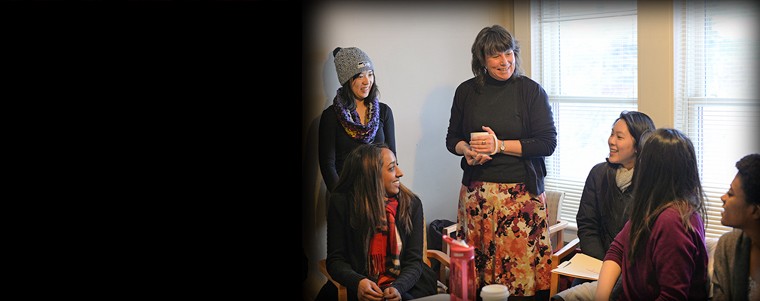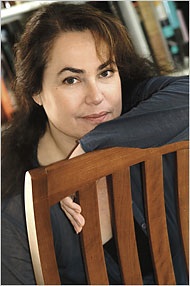Peter Rutland, the Colin and Nancy Campbell Professor in Global Issues and Democratic Thoughts, writes in the Mirror (U.K.) about the threat to the West by Russian President Vladimir Putin. He considers the comparison made by British Defense Secretary Michael Fallon to the Islamic State. While "Putin's people are not beheading Christians or burning captives alive," writes Rutland, Russia has nuclear weapons — lots of them. "And is willing to use them if necessary," he writes. "Deterrence only works if both sides see each other as unwilling to risk war. And [Putin] believes the West will not risk nuclear conflict over where to…
Phil Resor, associate professor of earth and environmental sciences, and Gus Seixas '10 are co-authors of "Constraints on the evolution of vertical deformation and Colorado River incision near eastern Lake Mead, Arizona, provided by quantitative structural mapping of the Hualapai Limestone," published in the February 2015 issue of Geosphere, Vol. 11, pages 31-49. The paper includes research from Seixas's honors thesis at Wesleyan. In this study, the authors quantify the structural geometry of Hualapai Limestone, which was deposited in a series of basins that lie in the path of the Colorado River. The limestone was deformed by by a fault pair…
Richard Grossman, professor of economics, is featured in a radio interview with Share Radio in London Feb. 19. In the interview, Grossman talks about the consequences of the European Central Bank's new quantitative easing (QE) policy, which may stimulate an economy when a standard monetary policy has become ineffective. The ECB's action follows in the footsteps of the central banks of Japan, the United Kingdom, and the United States, which also have used quantitative easing in the 2000s. A concern that has been raised about the introduction of QE is that persistent low interest rates will lead to another boom-bust…
Bill Craighead, assistant professor of economics, is the co-author of "Current Account Reversals and Structural Change in Developing and Industrialized Countries," published in the February issue of The Journal of International Trade and Economic Development. The paper compares the experience of high-income and developing countries in adjusting current account deficits, which measure how much they are relying on external borrowing. In both types of country, construction is the most sensitive sector to the current account. On average, adjustments in developing countries are more severe, but that is mainly due to the effects of currency crises. When you take those out, they…
Early this year, Gary Shteyngart embarked on an experiment for The New York Times: For a week straight, he would "subsist almost entirely on a diet of state-controlled Russian television, piped in from three Apple laptops onto three 55-inch Samsung monitors in a room at the Four Seasons Hotel in Manhattan." Assistant Professor of Art Sasha Rudensky documented this experiment in a series of photographs that accompany the story. Here is Shteyngart lying in bed, feet encased in hotel slippers, while Russian President Vladamir Putin's stern face fills three towering television screens. Here Shteyngart is dining on Wagyu beef slices and sipping pinot noir…
#THISISWHY About 30 Wesleyan students and faculty gathered for a Wesleyan Women in Science (WesWIS) Tea Reception Feb. 19 at the Wasch Center. Women in Science is a student group composed of undergraduates, post-docs, staff and faculty dedicated to issues affecting women in science. The group is open to all majors and genders. During the gathering, guest speaker Michelle Francl, professor of chemistry on the Clowes Fund for Science and Public Policy at Bryn Mawr College, spoke to the group about physicist and chemist Marie Curie, the first woman to win a Nobel Prize. Francl handed out copies of her commentary titled…
Novelist Amy Bloom '75, the Distinguished University Writer-in-Residence, director of the Shapiro Center for Creative Writing, is co-hosting a new weekly podcast titled "Ethicists." The podcast, a re-imagination of the New York Times Magazine’s longtime “The Ethicist” column, features Bloom and two other ethicists answering questions for a half-hour. NYT Magazine Editor-in-Chief and Wesleyan alumnus Jake Silverstein '98 invited Bloom to participate in the show. The other panelists are Politico media columnist Jack Shafer and New York School of Law constitutional law professor Kenji Yoshino. The first episode, titled "Close Quarters: Can I ask my neighbors to quiet their baby?" debuted Feb. 18 and is produced…
Mike Singer, associate professor of biology, associate professor of environmental studies, is the co-author of several recently-published papers. They include: “Thee struggle for safety: effectiveness of caterpillar defenses against bird predation,” is in press and will appear in the April 2015 issue of Oikos. This article shows how the camouflaged or bold appearance of a caterpillar can protect it from predatory birds in Connecticut forests. Former BA/MA student, Isaac Lichter-Marck '11, '12, is the first author of this article. “Defensive mixology: Combining acquired chemicals toward defense,” is published in Functional Ecology, 2015. This article proposes a conceptual framework to study the use of natural drug cocktails by animals…
Brian Northrop, assistant professor of chemistry, is the co-author of several new papers including: “Preparation and Analysis of Cyclodextrin-Based Metal-Organic Frameworks: Laboratory Experiments Adaptable for High School through Advanced Undergraduate Students,” published in Journal of Chemical Education 92, pages 368-372, 2015. Samantha Angle, a Middletown High School student working in Northrop’s lab, co-authored the paper. (See cover at left.) "Rational Synthesis of Bis(hexyloxy)-Tetra(hydroxy)-Triphenylenes and their Derivatives," published in RSC Advances 4, pages 38,281-392 in 2014; "Vibrational Properties of Boroxine Anhydride and Boronate Ester Materials: Model Systems for the Diagnostic Characterization of Covalent Organic Frameworks,” published in Chemistry of Materials 26, pages 3,781-95 in 2014; And “Allyl-Functionalized Dioxynaphthalene[38]Crown-10 Macrocycles: Synthesis, Self-Assembly,…
Stewart Novick, chair and professor of chemistry, is the co-author of several papers published in 2014. They include: "The microwave spectra and structure of the argon-cyclopentanone and neon-cyclopentanone van der Waals complexes," published in the Journal of Physical Chemistry A 118, pages 856-861; "The shape of trifluoromethoxybenzene," published in the Journal of Molecular Spectroscopy 297, pages 32-34; "Fluorination effects on the shapes of complexes of water with ethers: a rotational study of trifluoroanisole-water," published in the Journal of Physical Chemistry, A 118, pages 1,047-51; "Measurement of the J = 1 - 0 pure rotational transition in excited vibrational states of…
Michael Frisch, research professor of in chemistry, is the co-author of many articles published in 2014. They include: “Analytical harmonic vibrational frequencies for the green fluorescent protein computed with ONIOM: Chromophore mode character and its response to environment," published in the Journal of Chemical Theory and Computation, 10, pages 751-766; “Quantum calculations in solution for large to very large molecules: A new linear scaling QM/continuum approach," published in the Journal of Physical Chemical Letters, 5, pages 953-958; “Density of states guided Møller-Plesset perturbation theory,” published in the Journal of Chemical Theory and Computation, 10, pages 1,910-14; “Practical auxiliary basis implementation…
A Body in Fukushima, a series of color photographs and video presented in a groundbreaking exhibition across three Wesleyan galleries, is on display through April. The series is an exploration into the area around the Fukushima Daiichi Nuclear Power Plant, which destabilized and melted down after a magnitude 9.0 earthquake and tsunami in March 2011. The power plant released radioactive materials into the surrounding environment. In 2014, dancer-choreographer Eiko Otake and photographer/historian William Johnston followed abandoned train tracks through desolate stations into eerily vacant towns and fields in Fukushima, Japan. Otake is a visiting instructor in dance and Johnston is professor of history, professor of…




